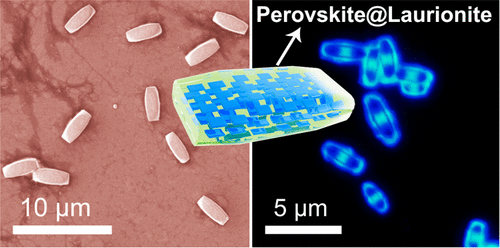当前位置:
X-MOL 学术
›
Nano Lett.
›
论文详情
Our official English website, www.x-mol.net, welcomes your feedback! (Note: you will need to create a separate account there.)
Ultrastable Laurionite Spontaneously Encapsulates Reduced-dimensional Lead Halide Perovskites
Nano Letters ( IF 10.8 ) Pub Date : 2020-03-23 , DOI: 10.1021/acs.nanolett.9b04730 Yangchun Yu 1 , Jiahui Hou 1 , Linghui Zhang 1, 2 , Qisheng Sun 1, 2 , Sanam Attique 1 , Weijian Wang 1 , Xiuxia Xu 3 , Fan Xu 4 , Zhipeng Ci 2 , Bingqiang Cao 4 , Xvsheng Qiao 3 , Xiangheng Xiao 5 , Shikuan Yang 1
Nano Letters ( IF 10.8 ) Pub Date : 2020-03-23 , DOI: 10.1021/acs.nanolett.9b04730 Yangchun Yu 1 , Jiahui Hou 1 , Linghui Zhang 1, 2 , Qisheng Sun 1, 2 , Sanam Attique 1 , Weijian Wang 1 , Xiuxia Xu 3 , Fan Xu 4 , Zhipeng Ci 2 , Bingqiang Cao 4 , Xvsheng Qiao 3 , Xiangheng Xiao 5 , Shikuan Yang 1
Affiliation

|
Reduced dimensional lead halide perovskites (RDPs) have attracted great research interest in diverse optical and optoelectronic fields. However, their poor stability is one of the most challenging obstacles prohibiting them from practical applications. Here, we reveal that ultrastable laurionite-type Pb(OH)Br can spontaneously encapsulate the RDPs in their formation solution without introducing any additional chemicals, forming RDP@Pb(OH)Br core–shell microparticles. Interestingly, the number of the perovskite layers within the RDPs can be conveniently and precisely controlled by varying the amount of CsBr introduced into the reaction solution. A single RDP@Pb(OH)Br core–shell microparticle composed of RDP nanocrystals with different numbers of perovskite layers can be also prepared, showing different colors under different light excitations. More interestingly, barcoded RDP@Pb(OH)Br microparticles with different parts emitting different lights can also be prepared. The morphology of the emitting microstructures can be conveniently manipulated. The RDP@Pb(OH)Br microparticles demonstrate outstanding environmental, chemical, thermal, and optical stability, as well as strong resistance to anion exchange processes. This study not only deepens our understanding of the reaction processes in the extensively used saturation recrystallization method but also points out that it is highly possible to dramatically improve the performance of the optoelectronic devices through manipulating the spontaneous formation process of Pb(OH)Br.
中文翻译:

超稳定月桂石自发地封装了尺寸减小的卤化铅钙钛矿
尺寸减小的卤化铅钙钛矿(RDP)在各种光学和光电领域引起了极大的研究兴趣。但是,它们的稳定性差是阻止其实际应用的最具挑战性的障碍之一。在这里,我们揭示了超稳定的月桂石型Pb(OH)Br可以自发地将RDP封装在它们的形成溶液中,而无需引入任何其他化学物质,从而形成RDP @ Pb(OH)Br核-壳微粒。有趣的是,通过改变引入反应溶液中的CsBr的量,可以方便而精确地控制RDP中钙钛矿层的数量。还可制备由具有不同钙钛矿层数的RDP纳米晶体组成的单个RDP @ Pb(OH)Br核-壳微粒,在不同的光激发下显示出不同的颜色。更有趣的是,还可以制备具有不同部分发射不同光的条形码化的RDP @ Pb(OH)Br微粒。发射微结构的形态可以方便地操纵。RDP @ Pb(OH)Br微粒表现出出色的环境,化学,热和光学稳定性,以及对阴离子交换过程的强大抵抗力。这项研究不仅加深了我们对广泛使用的饱和重结晶方法中反应过程的理解,而且指出通过操纵Pb(OH)Br的自发形成过程来极大地提高光电器件的性能是非常可能的。发射微结构的形态可以方便地操纵。RDP @ Pb(OH)Br微粒表现出出色的环境,化学,热和光学稳定性,以及对阴离子交换过程的强大抵抗力。这项研究不仅加深了我们对广泛使用的饱和重结晶方法中反应过程的理解,而且指出通过操纵Pb(OH)Br的自发形成过程来极大地提高光电器件的性能是非常可能的。发射微结构的形态可以方便地操纵。RDP @ Pb(OH)Br微粒表现出出色的环境,化学,热和光学稳定性,以及对阴离子交换过程的强大抵抗力。这项研究不仅加深了我们对广泛使用的饱和重结晶方法中反应过程的理解,而且指出通过操纵Pb(OH)Br的自发形成过程来极大地提高光电器件的性能是非常可能的。
更新日期:2020-03-23
中文翻译:

超稳定月桂石自发地封装了尺寸减小的卤化铅钙钛矿
尺寸减小的卤化铅钙钛矿(RDP)在各种光学和光电领域引起了极大的研究兴趣。但是,它们的稳定性差是阻止其实际应用的最具挑战性的障碍之一。在这里,我们揭示了超稳定的月桂石型Pb(OH)Br可以自发地将RDP封装在它们的形成溶液中,而无需引入任何其他化学物质,从而形成RDP @ Pb(OH)Br核-壳微粒。有趣的是,通过改变引入反应溶液中的CsBr的量,可以方便而精确地控制RDP中钙钛矿层的数量。还可制备由具有不同钙钛矿层数的RDP纳米晶体组成的单个RDP @ Pb(OH)Br核-壳微粒,在不同的光激发下显示出不同的颜色。更有趣的是,还可以制备具有不同部分发射不同光的条形码化的RDP @ Pb(OH)Br微粒。发射微结构的形态可以方便地操纵。RDP @ Pb(OH)Br微粒表现出出色的环境,化学,热和光学稳定性,以及对阴离子交换过程的强大抵抗力。这项研究不仅加深了我们对广泛使用的饱和重结晶方法中反应过程的理解,而且指出通过操纵Pb(OH)Br的自发形成过程来极大地提高光电器件的性能是非常可能的。发射微结构的形态可以方便地操纵。RDP @ Pb(OH)Br微粒表现出出色的环境,化学,热和光学稳定性,以及对阴离子交换过程的强大抵抗力。这项研究不仅加深了我们对广泛使用的饱和重结晶方法中反应过程的理解,而且指出通过操纵Pb(OH)Br的自发形成过程来极大地提高光电器件的性能是非常可能的。发射微结构的形态可以方便地操纵。RDP @ Pb(OH)Br微粒表现出出色的环境,化学,热和光学稳定性,以及对阴离子交换过程的强大抵抗力。这项研究不仅加深了我们对广泛使用的饱和重结晶方法中反应过程的理解,而且指出通过操纵Pb(OH)Br的自发形成过程来极大地提高光电器件的性能是非常可能的。



























 京公网安备 11010802027423号
京公网安备 11010802027423号